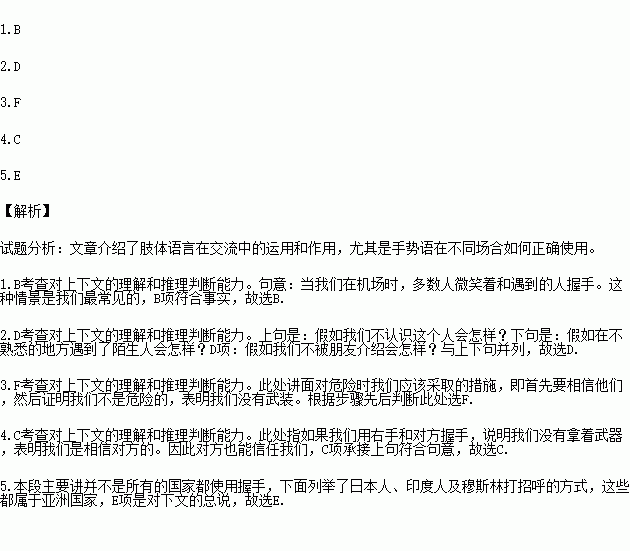题目内容
根据短文内容,从短文后的选项中选出能填入空白处的最佳选项。选项中有两项为多余选项。
The Open Hand — a Universal Sign
When meeting people at the airport, 1. We know that a smile is usually a sign that people feel friendly and happy, but what if we don’t know who the new person is? 2. What if we are meeting a stranger in an unfamiliar place? Sometimes people are dangerous and humans have to find ways to protect themselves. We have to make sure we can trust people we do not know, 3. Showing our hands means that we are not armed(武装). In many cultures today, the Western custom of shaking hands is used. We use our right hand, which is usually stronger than the left one. If we are using our hand this way, it cannot be holding a knife or a gun. It shows that we trust the other person, 4.
Not all cultures use the handshake, 5. Japanese people might cover one hand with the other and, depending on whom they are greeting, bow slightly or quite low. In India, Hindu people join their hands in front of their faces and bow their heads. A Muslim will touch his heart, mouth and forehead(前额)to show respect. Even young people in the West now give each other the “high five”, when they slap(拍)each other’s hands high in the air. They are all keeping their hands busy. In almost all cultures, to smile and show an open right hand means, “Welcome, you are safe with me.”
A. What if I want to show that I am bored?
B. most people smile and shake hands with people they meet.
C. and that the other person can trust us.
D. What if we are not introduced by a friend?
E. and people in many Asian cultures do not always touch another person.
F. and we have to show that we are not dangerous.
G. nor are they comfortable in the same way with touching or distance between people.
 一线名师权威作业本系列答案
一线名师权威作业本系列答案
